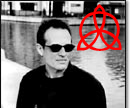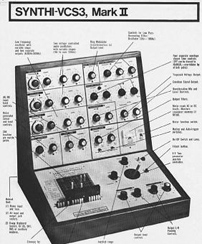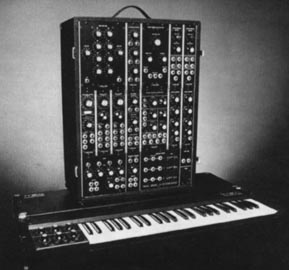

The Electronic Music Studios (EMS) of London, England produced synthesizers that were not widely distributed, but were used on many great albums. Their Synthi and VCS3 (variations on a simple 3-oscillator design) were used on classic rock records, such as The Dark Side of the Moon (Pink Floyd) and Who's Next (The Who). John Paul Jones used his VCS3 on many important Led Zeppelin tracks, as well.
The VCS3 was a semi-modular analog synthesizer; that is, it had patchable routing using a small matrix panel. The player would insert metal pins in this panel and connect sections of the synthesizer together. With careful design, a creative synthesist could make incredibly complex sounds from only a few components. The VCS3 has three oscillators, a lowpass filter, a noise generator, a ring modulator, envelope generator, and reverb. At the bottom of the unit is a joystick that allows the player to control several parameters simultaneously. Jones liked the VCS3, and used it often, although he said it was "murder to keep in tune" and "wasn't sophisticated enough to sound like a synthesizer" (which he liked!).
 Jones
used the VCS3 to create the underwater "wobble" effect on "No Quarter."
He ran the audio signal of the Hohner piano through the filter, and modulated
the filter with a sine-wave LFO. This made the filter rise and fall rapidly,
creating a shifting tone not unlike a phaser, or Leslie speaker. (This
is similar to Pete Townshend's use of the VCS3 on "Won't Get Fooled Again,"
where a Hammond was processed through the synth to create a pulsing organ
tone.) The VCS3 has no standard keyboard, but it can be used with an external
keyboard controller, the DK1.
Jones
used the VCS3 to create the underwater "wobble" effect on "No Quarter."
He ran the audio signal of the Hohner piano through the filter, and modulated
the filter with a sine-wave LFO. This made the filter rise and fall rapidly,
creating a shifting tone not unlike a phaser, or Leslie speaker. (This
is similar to Pete Townshend's use of the VCS3 on "Won't Get Fooled Again,"
where a Hammond was processed through the synth to create a pulsing organ
tone.) The VCS3 has no standard keyboard, but it can be used with an external
keyboard controller, the DK1.
"The Crunge" from Houses of the Holy also contains the VCS3, which
makes the strange hornlike parts. These parts were overdubbed seperately
to create a polyphonic "brass section." The song was created mostly live
in the studio as an improvisation, to not only reinforce the James Brown
dance feel, but also add structure to the long, repetitive jam.
"In The Light" from Physical Graffiti begins with a Middle-Eastern guitar drone piece, and a strange reedlike instrument solos over this. This melody is played by Jones on the EMS synth, and makes excellent use of its joystick to create a pitch-bend, similar to the expression used by Arabic musicians. The strangeness of the sound is enhanced by a delay, which creates a distant, hazy sound.
The VCS3 is also used for special overdub sounds in "Four Sticks," "The Rain Song," and a small overdub at 6:54 in "Achilles Last Stand." On the transition from "Friends" to "Celebration Day," a VCS3 drones, with subtle filter sweeps. The EMS reverb, an old spring-type reverb (also found in guitar amps), is clearly audible between the two songs.
John Paul Jones also owns a small Moog modular synth: The Moog 15. It is similar in function to the VCS3 and has been used occaisionally on his recorded work. At this point, it is unclear which tracks utilized it -- he mainly used the VCS3 for Led Zeppelin. See both synths below as they appear in The Malthouse (his studio) today.
 |
|
(Photo courtesy Keyboard
magazine / Japan)
|
�